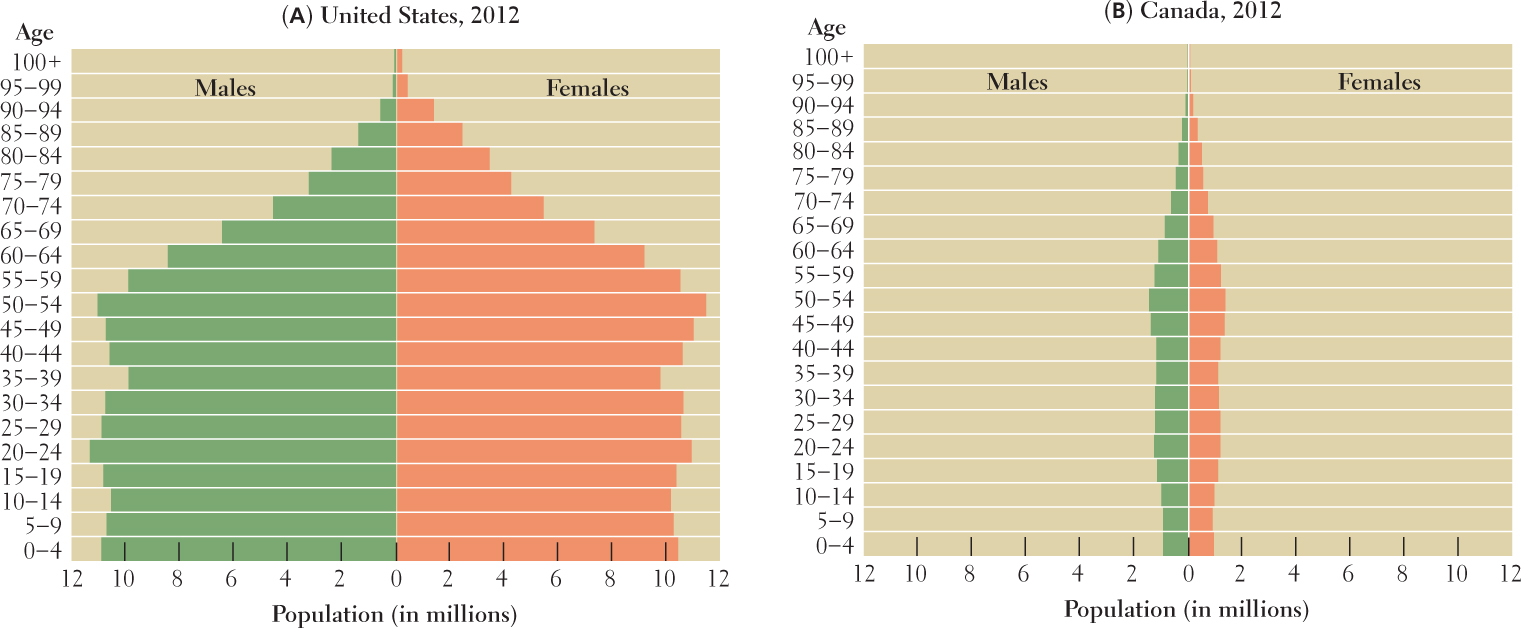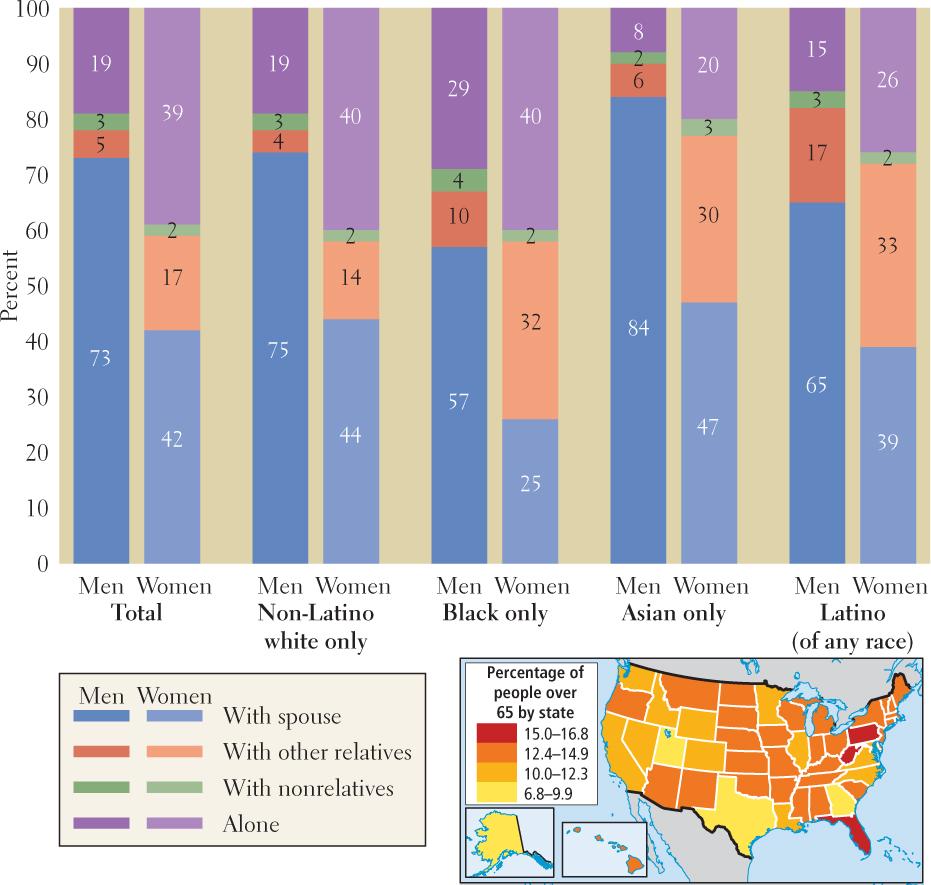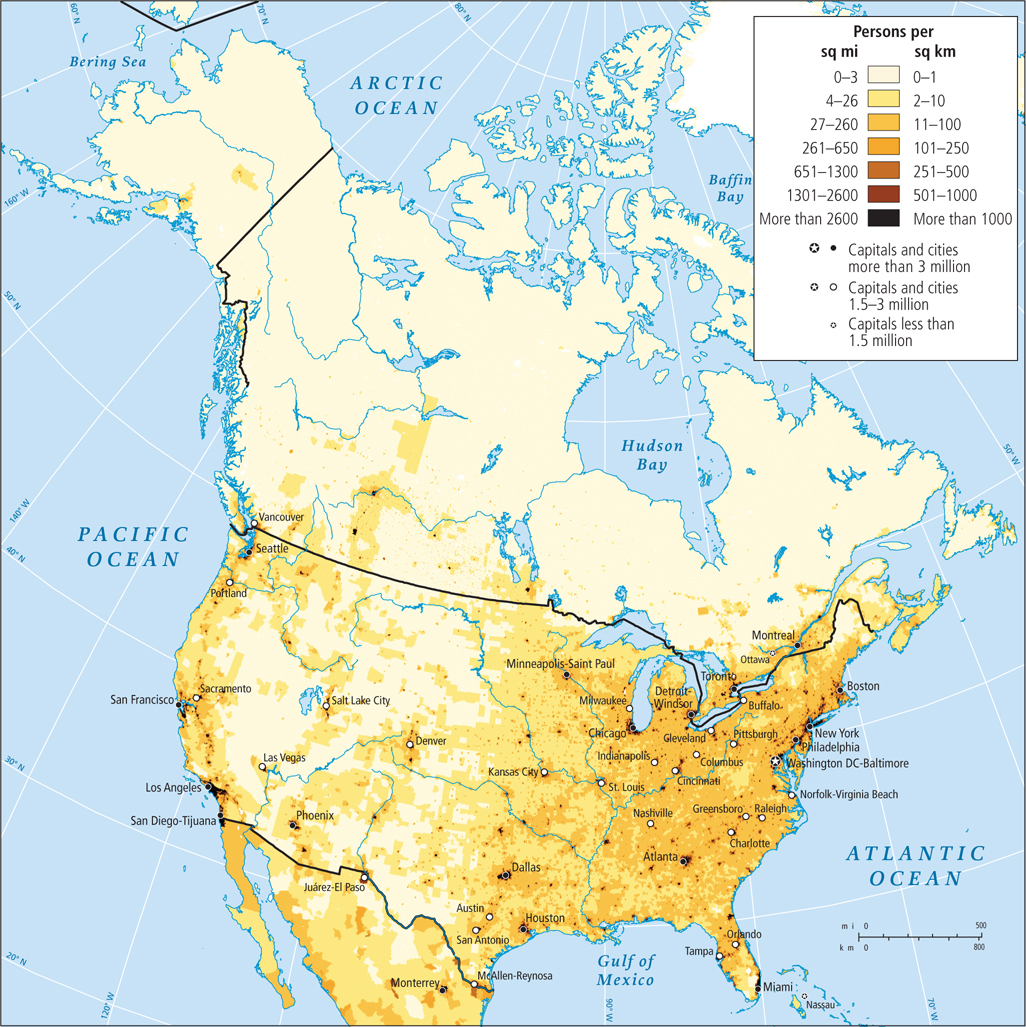2.9 POPULATION AND GENDER
GEOGRAPHIC INSIGHT 5
Population and Gender: Women’s participation in North America’s economy is beginning to rival that of men, contributing to more than two centuries of declining fertility rates as women delay childbearing to pursue education and careers. Declining childbirth rates play a major role in the aging of North American populations, which may slow economic growth.
Gender and Fertility
North America is well along the demographic transition, with the number of children the average woman will have in her lifetime (also known as the fertility rate) declining since the early 1800s. This has happened in response to a number of factors: increasing economic development, improved health care, urbanization, and more women participating in the workforce.
All of these factors are connected in how they influence fertility. For example, social scientists have documented that increasing economic development is associated with decreased fertility. It is also usually associated with more women participating in the workforce, higher rates of urbanization, and improved health care. Similarly, urbanization is also associated with more women in the workforce, as families that move to the city are more likely to need the cash income that an adult woman who works outside the home can provide. This in turn is associated with lower fertility because women who have careers tend to delay childbearing. With regard to health care, improvements in the quality of health care and better access to medical professionals and medicines tend to lower the fertility rate as families choose to have fewer children because more will survive into adulthood. This choice is made easier with better access to birth control. All of these factors have come together to influence both gender and fertility in North America.
By the early 1800s, small numbers of North American women were starting to work in urban factories, where they had better access to health care. As more women chose this path, the fertility rate fell steadily from a high of 7 births per woman in 1800 to 3 births per woman in the 1920s. After the rapid rise in fertility following World War II, there was a sharp fertility decline as North American women worked more and gained access to birth control via “the pill,” which became widespread in the 1960s. Since a low in the 1970s, North American fertility rates have remained more or less flat, at a level just below replacement level, contributing to an overall aging of populations.
Aging in North America
During the twentieth century, the number of older North Americans grew rapidly. In 1900, one in 25 individuals was over the age of 65; by 2010, the number was 1 in 8. By 2050, when most of the current readers of this book will be over 50, it is likely that 1 in 5 North Americans will be elderly.
What Causes a Population to Age? This aging of the region’s population relates both to longer life expectancy, which increases the number of older people, and to a declining fertility rate, which decreases the number of younger people (Figure 2.25). While life expectancy increased steadily throughout the twentieth century, fertility rates declined significantly after the 1960s, when more women chose to obtain more education and pursue careers, resulting in their having fewer children.

The number of North Americans over the age of 65 is already high by global standards and will increase dramatically over the next 20 years. This will result from the combination of the marked jump in birth rate that took place after World War II during the baby boom of 1947 to 1964, and the ensuing drop in birth rate that occurred after 1965, as women had fewer children. The baby boomers constitute the largest age group in North America.
Dilemmas of Aging Aging populations in developed countries like Canada and the United States present us with unfamiliar and as-
Given that the population is aging, should retirement ages be extended from 65 to perhaps 75? Might this deprive young people of access to jobs? These worries have greatly preoccupied Europeans, for whom retirement ages can be as low as 58 and whose populations are aging faster than those of North America. Economists who have studied this issue say that it clearly makes sense to extend the retirement age. First, this means those over 65 will remain self-
Eventually most elderly people will need special attention of some sort. To avoid the social isolation that so many elderly are already encountering, it will be necessary to develop affordable alternative living arrangements. Figure 2.26 shows how the elderly of various ethnic groups in the United States are living now. Notice how elderly women in all groups are the ones most likely to live alone. Although North Americans of all ages are choosing to live alone more than they did in the past, this can be problematic for the elderly as physical frailty increases and incomes shrink. Day care and cohousing for the elderly, where residents look after each other with the aid of a small staff, are two affordable strategies to provide care and companionship.

Population Distribution
The population map of North America (Figure 2.27) shows the uneven distribution of the more than 352 million people who live here. Canadians make up just under one-

The Geography of Population Change in North America Every year, almost one-
In many farm towns and rural areas in the Middle West, or Midwest (the large central farming region of North America), populations are shrinking. As family farms are consolidated under corporate ownership, labor needs are decreasing and young people are choosing better-
In the western mountainous interior, traditionally settlement has been light (see Figure 2.27). The principal reasons for this low density are rugged topography and lack of rain, and in northern or high-
Along the Pacific coast, a band of growing population centers stretches north from San Diego to Vancouver (see Figure 2.21A) and includes Los Angeles, San Francisco, Portland, and Seattle. These are all port cities engaged in trade around the Pacific Rim (all the countries that border the Pacific Ocean). Over the past several decades, these North American cities have become centers of technological innovation.
Pacific Rim a term that refers to all the countries that border the Pacific Ocean
The rate of natural increase in North America (0.5 percent per year) is low, less than half the rate of the rest of the Americas (1.2 percent). Still, North Americans are adding to their numbers fast enough through births and immigration that the population could reach more than 422 million by 2050.
THINGS TO REMEMBER
GEOGRAPHIC INSIGHT 5
Population and Gender Women’s participation in North America’s economy is beginning to rival that of men, contributing to more than two centuries of declining fertility rates as women delay childbearing to pursue education and careers. Declining childbirth rates play a major role in the aging of North American populations, which may slow economic growth.
North America’s population is rapidly aging, and by 2050, one in five people will be over the age of 65. There will be fewer young people to work, pay taxes, and take care of the elderly.
The population of North America is changing in distribution and becoming more diverse.
North Americans are highly mobile. Every year, for a variety of reasons, almost one-
fifth of the U.S. population and two- fifths of the Canadian population move to a different location.
 52. LATINO POLITICAL POWER
52. LATINO POLITICAL POWER